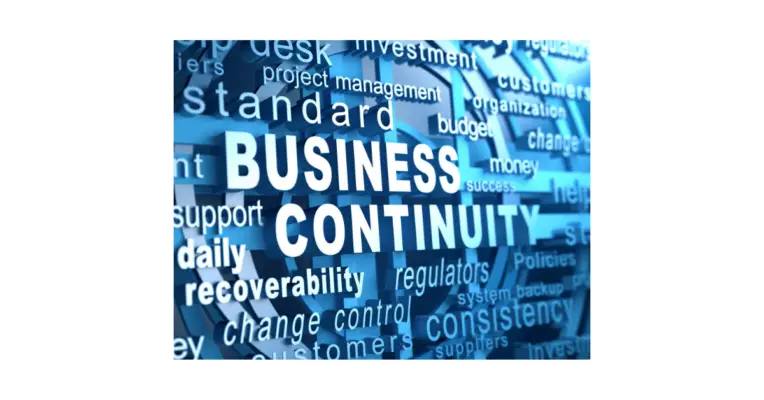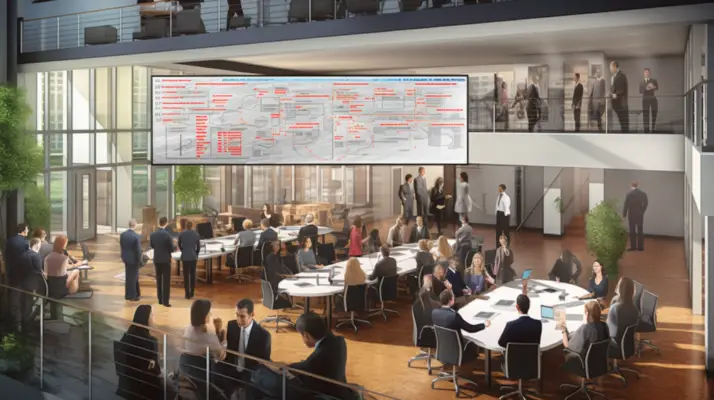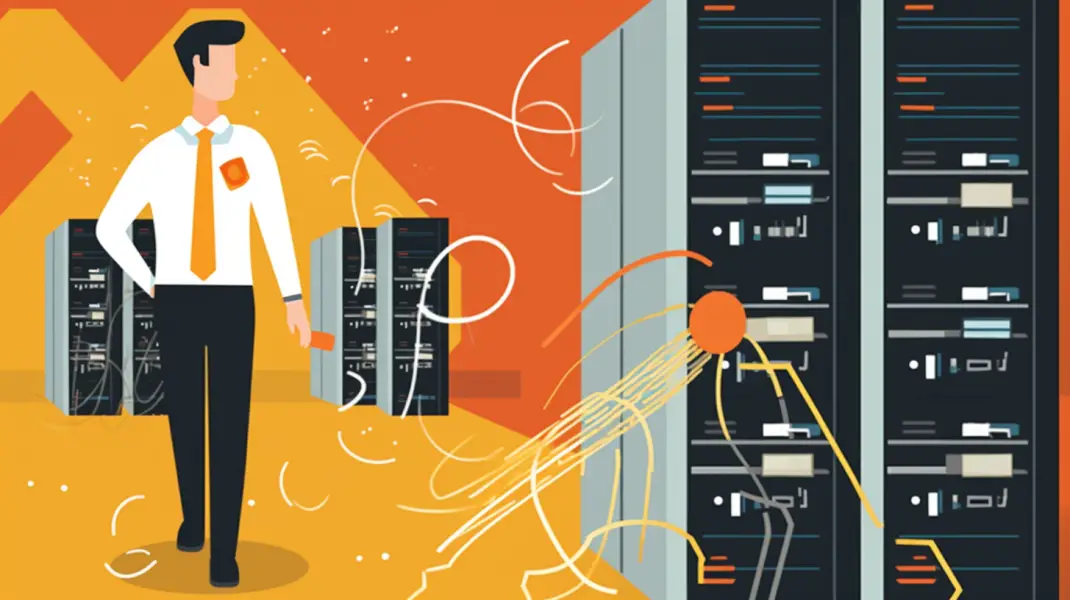Business Continuity Plan (BCP) and Disaster Recovery Plan (DRP) are two critical strategies businesses must implement to protect themselves from potential disruptions.
These strategies involve planning, preparing, and executing measures to help organizations maintain operations and recover from unexpected cyber-attacks, natural disasters, and other emergencies.
Although these terms are often used interchangeably, they have distinct differences that businesses need to understand to ensure maximum protection.
BC focuses on maintaining a level of function during a disaster, while DR outlines resolving a disruption after the event.
BC plans typically involve identifying critical business functions, creating redundancies, and establishing procedures to ensure essential services can continue during a disaster.
On the other hand, DR is recovering from disruption and returning to normal operations.
DR plans typically involve restoring data, applications, and systems to their pre-disaster state, minimizing downtime, and avoiding data loss.
This article will explore the differences between BC and DR, their components, testing methods, and key points that businesses must consider when implementing these strategies.

BCP vs DRP
The distinction between a Business Continuity Plan (BCP) and a Disaster Recovery Plan (DRP) is crucial for businesses to understand to effectively protect themselves from potential disruptions.
BCP is a proactive approach that ensures the maintenance of business functions during a crisis. At the same time, DRP is a reactive approach that outlines resolving a disruption after the event. Both plans are essential for businesses to survive and recover from disasters.
While BCP focuses on preventing disruptions and ensuring business continuity, DRP restores the infrastructure after a disaster.
BCP includes defining the team, performing a business impact analysis, outlining crisis communication channels, training and educating employees and regularly testing and maintaining the strategy.
On the other hand, DRP includes defining the team, identifying business-critical functions and potential vulnerabilities, creating a disaster recovery plan, creating backup procedures, training and educating staff, and regularly testing, analyzing, and maintaining the DR plan.
Testing methods are crucial for both plans to ensure effectiveness and identify areas for improvement.
Infrastructure and communication plans are also critical components of both plans.
Having both a BCP and a DRP significantly decreases the impact of an event, protecting the business and stakeholders.
| Category | Disaster Recovery Plan (DRP) | Business Continuity Plan (BCP) |
|---|---|---|
| Definition | A Disaster Recovery Plan (DRP) is a documented, structured approach with instructions for responding to unplanned incidents. | Business Continuity Plan (BCP) is a strategy to ensure that business processes can continue during a time of emergency or disaster. |
| Objective | Focuses mainly on IT and technological systems recovery. | The objective is to maintain essential functions during and after a disaster has occurred. |
| Scope | Focuses mainly on the IT and technological systems recovery. | Covers all aspects of the organization, not just IT. |
| Focus Areas | Data recovery, system recovery, communication, and hardware. | Business processes, assets, human resources, business partners. |
| Implementation | Implemented after a disaster occurs to recover IT systems and operations. | Implemented before, during, and after an incident to ensure critical operations continue. |
Using proactive and reactive measures to prevent and address potential disruptions, businesses can ensure their survival and continuity in the face of disasters.
Components
Elements crucial for a successful business continuity and disaster recovery plan include defining the team, performing a business impact analysis, outlining crisis communication channels, training and educating employees, and regularly testing and maintaining the strategy.
A business continuity plan (BCP) is proactive, while a disaster recovery plan (DRP) is reactive. Therefore, a BCP should be set in motion as the crisis or event is happening and sustained until the crisis has been resolved.
In contrast, a DRP would be set in motion once the emergency is over and will continue until the business has returned to ‘normal.’
Defining the team for both the BCP and DRP is crucial, as it ensures a clear understanding of who has specific roles and responsibilities during a crisis.
A business impact analysis is also essential, as it helps identify critical business functions, potential vulnerabilities, and the resources necessary to recover from a disaster.
Outlining crisis communication channels ensures that employees, stakeholders, and customers are kept informed and updated during a crisis.
Training and educating employees also play a significant role in both plans as it ensures everyone knows the procedures and protocols necessary during a crisis.
Regularly testing and maintaining the BCP and DRP is essential to ensure they remain effective and up-to-date.
A successful business continuity plan and disaster recovery plan are essential for any business to ensure that it can continue to operate during and after a crisis.
While both plans have different objectives, they share common elements, such as defining the team, performing a business impact analysis, outlining crisis communication channels, training and educating employees, and regularly testing and maintaining the strategy.
Companies that invest in a BCP and DRP significantly decrease the impact of an event, protecting the business and stakeholders.
Testing Methods
Various testing methods are available for disaster recovery plans, including Walkthrough Testing, Simulation Testing, Checklist Testing, Full Interruption Testing, and Parallel Testing.
These testing methods are crucial for businesses to exercise recovery processes and procedures, familiarize staff with recovery process and documentation, verify recovery documentation’s effectiveness and site’s effectiveness, and establish if recovery objectives are achievable.
Testing is essential to disaster recovery planning, and businesses should regularly test their plans to ensure their effectiveness.
Simulation testing is one of disaster recovery plans’ most crucial testing methods. This method involves creating a simulated disaster situation to test the business continuity plan’s effectiveness.
This testing method is important because it allows employees to experience what it would be like to respond to a disaster and ensure they know what to do in such an event.
Full interruption testing is another method involving shutting down critical systems to test the recovery process.
Parallel testing involves setting up a separate system replicating the primary system to test its effectiveness during a disaster.
Testing methods are crucial components of disaster recovery planning. Businesses should regularly test their plans to ensure effectiveness and identify improvement areas.
Simulation testing, full interruption testing, and parallel testing are some of the most commonly used testing methods for disaster recovery plans.
It is essential to note that testing is a continuous process, and businesses should regularly update their disaster recovery plans to ensure they can respond to any disaster effectively.
Key Points
Testing methods play a crucial role in ensuring the effectiveness of disaster recovery plans for businesses.
Testing is necessary to exercise recovery processes and procedures, familiarize staff with the recovery process and documentation, and verify the effectiveness of recovery documentation and site.
Furthermore, testing helps establish whether recovery objectives are achievable and identify improvements to DR strategy, infrastructure, and recovery processes.
Business continuity and disaster recovery plans must be proactive and reactive. Regular testing of both plans is a proactive measure to identify gaps and improve the plans.
The reactive aspect of testing helps businesses to respond to disruptions and protect stakeholders’ interests effectively.
Testing ensures stakeholders know their roles during a disaster and can respond effectively.
Communication plans must be tested to ensure stakeholders are well-informed during a disaster and that all necessary communication channels function effectively.
Testing is a critical component of disaster recovery plans and business continuity plans. The testing process helps businesses to identify gaps and improve their plans.
A comprehensive testing plan must be developed to ensure that DRPs and BCPs are effective and can protect stakeholders’ interests during and after a disaster.
Businesses must regularly test their plans and communication channels to ensure that they are functioning effectively and can respond promptly and appropriately.

Disaster Recovery Services
Disaster recovery services have become increasingly crucial for businesses due to the growing threats posed by natural disasters, cybercrime, power outages, and other potential disruptions.
A Gartner study revealed that 40% of businesses cannot recover after a major disaster, and one-third of those that recover go out of business within two years of the event.
This highlights the importance of having a comprehensive disaster recovery plan (DRP) that includes cloud-based disaster recovery systems.
Cloud-based disaster recovery systems provide businesses with a secure and reliable option to keep their data safe and secure. These cost-effective systems offer the latest technology to ensure business continuity even after a disaster.
Businesses can use these systems to establish recovery time objectives (RTOs) and recovery point objectives (RPOs) to ensure that critical systems and data are restored within a specific timeframe.
This enables businesses to continue operations after a disaster and avoid financial losses.
Disaster planning is crucial for businesses to prepare for potential disruptions, but having a solid business continuity plan (BCP) and DRP is equally important. A BCP should cover natural disasters and cyber-attacks and be developed by IT staff and upper management.
In contrast, a DRP should focus on restoring IT infrastructure after physical damage or destruction. Using both plans in place, businesses can significantly decrease the impact of a disaster and protect their stakeholders.
Frequently Asked Questions
What is the difference in cost between implementing a BCP and a DRP?
It is difficult to provide an exact cost comparison between implementing a BCP and a DRP as the components of each plan vary depending on the business’s needs and size.
However, technological advancements have made DRP implementation more affordable, and cloud-based disaster recovery systems provide a cost-effective solution for businesses of all sizes.
How often should a BCP and DRP be updated and tested?
BCP and DRP should be regularly updated and tested to ensure their effectiveness. The frequency of updates and testing should be determined by the organization’s risk assessment and any business operations or infrastructure changes.
What are some common challenges businesses face when implementing a BCP or DRP?
Common challenges businesses face when implementing a BCP or DRP include lack of management support, inadequate budget allocation, insufficient training and testing, incomplete risk assessments, and failure to keep plans up-to-date with changing business needs and emerging threats.
Can a BCP and DRP be combined into one comprehensive plan?
Yes, a BCP and DRP can be combined into one comprehensive plan, as they both aim to ensure business continuity and address different aspects of disaster management.
However, it is important to clearly define the goals and components of each plan to avoid confusion and ensure effective implementation.
Are there any legal requirements for businesses to have a BCP and DRP in place?
No specific legal requirements exist for businesses to have a BCP and DRP. Still, it is considered best practice for ensuring business continuity and minimizing the impact of disruptions.
Industries such as healthcare and finance may have regulatory requirements for BCP and DRP.

Conclusion
Business Continuity (BC) and Disaster Recovery (DR) are two distinct strategies businesses must implement to protect themselves from potential disruptions.
While BC focuses on maintaining a level of function during a disaster, DR outlines resolving a disruption after the event.
Businesses must understand the differences between these strategies to ensure maximum protection.
The components of BC and DR include risk assessments, backup and recovery plans, communication plans, and training and awareness programs. Testing methods such as tabletop exercises, functional testing, and full-scale testing are essential to ensure the effectiveness of these strategies.
Businesses need to consider key points when implementing these strategies, including identifying critical business functions, understanding the potential risks and impacts, and regularly reviewing and updating the plans.
Disaster Recovery Services can provide businesses with the necessary expertise and resources to develop and implement BC and DR strategies.

Chris Ekai is a Risk Management expert with over 10 years of experience in the field. He has a Master’s(MSc) degree in Risk Management from University of Portsmouth and is a CPA and Finance professional. He currently works as a Content Manager at Risk Publishing, writing about Enterprise Risk Management, Business Continuity Management and Project Management.

